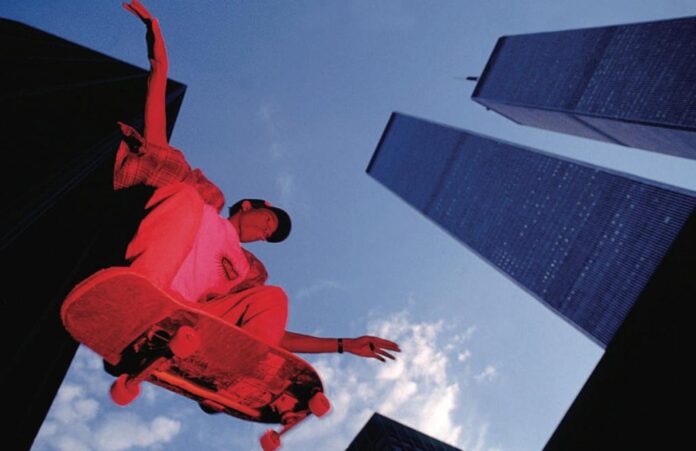A decade ago, Full Bleed: New York City Skateboard Photography arrived, stacked with some 300 pages of images by more than 40 photographers documenting three decades’ worth of skateboarding in the city. The hardcover contained no descriptions, chronology, or even page numbers; instead, it centered photographs, printed to the edges of every page, that bottled the kineticism and spirit of the urban sport.
On display throughout the book was obvious skateboarding prowess—riders in full flight, grinding rails, jumping stairs—but as well, stunning photographs lensed by the vaunted likes of Bryce Kanights, Spike Jonze, Jessica Bard, Atiba Jefferson, and Ed Templeton. They’re images that, as one of the book’s editors (and avid skateboarder) Alex Corporan emphasized, took immense patience and skill to capture.

Rodney Smith and Mike Kepper, by Bryce Kanights, 1989. Photo courtesy of .
“Skateboarding is not a consistent thing to do; it takes a lot of time to get it right. You want the skater to land the trick so [the image] can be published,” he told Artnet News. And in the time before digital photography, “the rolls and rolls of film were ridiculous. Sometimes there’s five rolls on the floor or 30—it was wild.”
A sought-after collector’s item, Full Bleed has now been rereleased in a 10th-anniversary edition, containing about 100 more pages of photographs as well as an introduction by skateboarding giant Tony Hawk. Revisiting the book, said Corporan, offered the opportunity to include material from new photographers and feature new skaters.

. Photo courtesy of .
“I felt that the book was ahead of its time 10 years ago because skateboarding just started getting more corporate and into the public eye,” he said. “I felt it was time to revisit and show skaters the NYC backdrop that has always been there for us.”
In fact, as much as the skateboarding and photography in its pages, Full Bleed offers an ode to the urban architecture of New York City. Or, at least, a skater’s version of the city landscape—its streets transformed into surfaces, plazas reimagined as banks.

Eli Reed, courthouse, by Allen Ying, 2000s. Photo courtesy of .
And while New York today houses more than 30 skate parks, Corporan is heartened that street skaters remain drawn to the city’s pavements, rails, stairs, and open spaces.
“The architecture is forever changing and that’s what keeps New York fresh when it comes to skateboarding,” he said. “All you have to do is push around the city and encounter new things and people from top to bottom, from left to right. That’s what keeps New York so special compared to the rest of the world, because all of the city is a skate spot.”
See more photographs from the 10th anniversary edition of Full Bleed below.

Mike Hernandez, Mullaly Park, by Spike Jonze (1990s). Photo courtesy of .

Eli Gesner & Alyasha, Phone Banks – Eli Gesner Files (1988). Photo courtesy of .

Betty T.V. show crew, Williamsburg Bridge by Alex Corporan. Photo courtesy of .

KoKi, 145th Street train gap, by Allen Ying. Photo courtesy of .

Rick Howard, by Atiba Jefferson (2008). Photo courtesy of .

Lauren Mollica, Chrystie Park, by Yuri Shibuya. Photo courtesy of .

NYC crew, Astor Place, by Melissa Hinkley (1990s). Photo courtesy of.

Skater, Brooklyn, by Brian Uyeda (2000s). Photo courtesy of .
“Full Bleed: New York City Skateboard Photography (10th Anniversary Edition),” edited by Alex Corporan, Ivory Serra, and Andre Razo, is available now on Salamander Street Ltd.

























